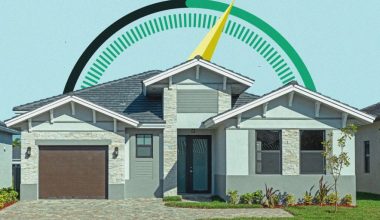The overall value of any property is determined by a number of factors, including the value of neighboring properties, residences, or companies. Real estate agents and brokers utilize methods such as the sales comparison approach to evaluate the value of a property in relation to nearby properties. Understanding how the sales comparison approach works will help you assess the value of homes and properties for purchase or sale more accurately. This post will explain what a sales comparison approach is and how to do the analysis.
What is the Sales Comparison Approach?
A sales comparison approach is a method used by real estate agents and brokers to evaluate the value of a property or home by comparing the subject home to others in the neighborhood that have recently sold with similar attributes. The sales comparison approach assists real estate brokers in maintaining fair pricing within the local market and provides a more realistic picture of the value of a home or property.
Understanding the Sales Comparison Methodology
Price adjustments are performed based on the qualities of the comparable property when determining the value of the subject property.
If the subject property lacks a characteristic feature in the comparable property, the price is reduced based on the value allocated to that feature. As a result, if the property has a valued quality that the comparable property does not, the value is adjusted upwards proportionately. It is repeated until a final value is reached after a comparison of at least three recently sold and comparable properties.
The sales comparison approach to valuing is an important aspect of appraisal specialists’ comparative market analysis. The comparative market approach is used to determine the current market value of the property that is being acquired. The sales comparison approach, when combined with other appraisal methodologies, provides an approximate estimate for sellers, investors, appraisers, and the general public.
Because real estate markets are dynamic and continually changing, investors should monitor the pricing of recently listed homes for sale on a regular basis. Markets fluctuate quickly, and all participants should be aware of current developments. Depending on the market conditions, sellers and investors may be forced to raise or drop their demands in order to keep up with market trends.
Locating the Best Comparable Property
A comparable property is one that most closely resembles the subject property. The similarities should correspond to all of the property’s general details. A property’s general description includes the number of bedrooms, bathrooms, square footage size, and so on. Allowable differences include an extra bath, paint color, and other trivial specifications.
The comparison of comparable properties should be limited to properties that are as near in physical location as possible. Because homes in different areas may have varying market prices despite having many similarities.
Residential flats near the central business center, for example, command a greater price than homes located further away from the CBD. Another factor to consider is purchasing residences that have been sold as recently as feasible.
Because real estate markets fluctuate on a regular basis, recently sold homes have better approximations than properties sold a few months or years ago. If there are no comparable properties in the same location, investigate recently-sold properties in surrounding locations rather than exploring further back in time.
Factors To Consider in a Sales Comparison Approach
Using a sales comparison approach necessitates several critical procedures. When executing a sales comparison approach, agents and brokers evaluate the following factors:
#1. Location
A property’s location is often the first consideration for a sales comparison approach. Different localities have different living costs, property taxes, and aesthetics that affect the overall value of a property. Some waterfront properties, for example, are more valuable due to their closeness to lakes, rivers, oceans, and beaches. Before evaluating other criteria, the agent or broker evaluates the property’s location to see if it influences the overall value.
#2. Neighborhood
Neighborhoods also have a significant impact on the value of a property or home. The proximity of a home to amenities such as schools, entertainment centers, parks and recreational facilities, and government buildings is determined by agents and brokers. Other considerations include the neighborhood’s crime rate, pollution levels, and proximity to noise from highways, industrial buildings, or natural elements.
#3. Recently Sold Listings
Recently sold listings in a certain area can provide insight into the entire market in that area. For example, if comparable houses in an area sold for $150,000, a realtor or agent can estimate that the subject home will sell for a higher or equivalent price. Recently sold listings can also help a broker or agent understand more about the neighborhood, such as what movement patterns exist and whether any pricing trends emerge.
#4. Age
The age of a home is also taken into account in the comparison sales approach. Agents and brokers take the age of the home into account because it can affect the value negatively or positively, depending on the area, the type of the home, and any updates that may be required.
Because of its more aesthetically beautiful brick facade and wood floors, an older Tudor-style home may sell for more than a modern home. It may also sell for less because it is over 100 years old and requires various significant and costly improvements to the electrical panels and plumbing.
A modern home in an older, Tudor-style neighborhood may be less expensive than its neighbors.
#5. Condition
One of the most crucial variables in the sales comparison approach is the condition of a home. A home’s condition includes:
- The state of the electrical panel
- Interior and exterior paint
- The state of the window
- Floors on the inside
- Condition of the furnace or heating system
- The condition of the roof
- Basement situation
- Condition of the kitchen and bathroom
There are numerous more factors of a home’s condition that can be used in the sales comparison approach, but these are the most prevalent. If two homes in a similar neighborhood both go on the market and one has a failing roof, the property with a functional, solid roof is likely to sell for a higher price.
Appraisal Adjustment Factors Using the Sales Comparison Approach
#1. Comparable characteristics
The subject property should be as similar to the comparable property as possible to minimize the requirement for adjustments. Adjustments result from comparison differences seen with the subject property.
#2. Ownership stake
Depending on the ownership interest in the subject property, the value of the subject can be modified to either higher or lower. A fee simple interest, for example, is valued differently from a fee interest under a lease. As a result, ownership is a difficult subject in valuation.
#3. Market conditions
Market conditions also play a role in valuation adjustments. Real estate prices can rise or fall depending on market conditions. Depending on the competition, sellers may lower their prices to improve their prospects of purchase. The market can alter in a couple of weeks.
#4. Location
Another factor to consider is the property’s location. Properties near critical infrastructure such as airports, roadways, CBDs, and so on are considered to be of higher value than those located further away.
Adjustments owing to variances between the subject property and comparable homes may also be influenced by key aspects such as traffic patterns, shopping facilities, and social amenities accessibility.
How To Conduct a Sales Comparison Approach
Using a sales comparison approach helps improve the accuracy and efficiency of the selling and buying process. Here’s how to conduct a sales comparison approach on any house or property:
#1. Identify market comparables
The first stage is to discover the “comparables” in the market. These are properties in the neighborhood that are most similar to the one you’re selling or buying. Look for prevalent architectural styles like Tudor, Cape Cod, Cottages, French Country, and Greek Revival. You can also look for properties that sold for a similar price to the original value of the subject residence.
By selecting which properties in the region most closely resemble the subject of your comparison, you can offer a foundation for your analysis.
#2. Determine the similarities between the comparables and the primary residence.
The following stage is to determine the similarities between your comparables and the principal home or property you’re buying or selling. This can include shared communities or geographical areas, age, condition, the market price at a given period in recent history, and pricing based on square footage. This allows you to discover the characteristics the subject home or property has in common with its comparables and where it may differ. Differences might increase the value of a home.
For example, if two Cape Cod-style homes are on the market at the same time, but one of them has a finished basement as well as a renovated kitchen and bathroom, that home may command a higher selling price than a comparable home without these features.
#3. Make adjustments to the values of comparables
Once you’ve identified the similarities between your comparables and your subject home, you can make adjustments to the comparables’ valuations depending on market trends and other considerations. Determine whether there have been major changes in the local market since the sale of your comparables. This can involve high prices or a general decline in the property market. You can also consider mortgage terms and income levels in the neighborhood, as well as the physical aspects that distinguish each similar.
#4. Add all of the components and adjustments together to get a final pricing estimate.
After you’ve accounted for all of your comparable information, you may start pricing the subject home. A common comparison sales approach is as follows:
Subject Home
- Tudor-style
- 100 years of age
- There are no substantial repairs required.
- Sold for $235,000 five years ago.
- Kitchen and bath renovations
- a secure neighborhood
- It’s close to attractions like an entertainment center and a five-star school system.
- 2,500 square foot large yard
Comparables
The first house
- Tudor-style.
- 115 years of age
- Roof repairs are required (estimated cost of $2,300).
- Sold for $139,000 a year ago.
- The kitchen and bathroom need to be updated.
- a secure neighborhood
- Nearby facilities include schools and parks.
- A small fenced-in yard
- a total of 2,700 square feet
Home number two:
- Cape Cod-style
- 70 years of age
- Basement repairs are required (estimated cost of $11,000).
- This year, it sold for $189,000
- Kitchen and bath renovations
- a secure neighborhood
- Schools, an amusement complex, parks, and theaters are all close.
- a large yard surrounded by a wooden fence
- a total of 2,800 square feet
The subject property is a 100-year-old Tudor-style mansion with 2,500 square feet of space and a huge yard. A Tudor and a Cape Cod-style home with nearly 2,000 square feet of room and safe neighborhoods are comparables. Using the comparable sales approach, you discover that properties one and two require considerable repairs ranging from $2,300 to $11,000 each. Each recently sold for a different value and had a distinct yard size.
Given that the home requires extensive roof repairs, the comparison shows that a Tudor-style home like the subject residence sells for roughly $140,000 or more. Both houses have safe neighborhoods, over 2,000 square feet, and nearby amenities. The equivalent Tudor, on the other hand, needs kitchen and bath updates and has a small fenced-in yard. Using the information from each home and the market’s health, you can estimate the subject home’s value to be between $150,000 and $200,000 dollars.
Conclusion
The sales comparison approach takes advantage of the similarities between the two properties being compared. The similarity varies from the date of the sale or listing to the description of the compared businesses. It is obvious that there are no identical, comparable units; thus, adjustments are required based on feature differences.
The sales comparison approach is strongly reliant on recent sales data, and it may not be accepted if no recent sales data are available. As a result, a real estate appraisal that lacks rich sales and recent data should employ alternative methods. However, if recent data is available, the sales comparison real estate valuation approach is the best choice.
- REAL ESTATE COMPS: Detailed Guide on Finding Real Estate Comps
- REAL ESTATE SOFTWARE: Best Software for Companies, Agents & Brokers
- Best 2023 REAL ESTATE INVESTMENTS & What You Should Know!!!
- Property Valuation: How to Value Your Real Estate Investment & Properties
- Comparative Market Analysis: Real Estate Management






